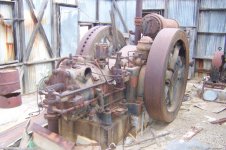I happen to own a 1929 Ingersoll Rand engine/compressor. It weighs 22 tons. I need to move it from a remote site to civilization. My plan was to make a sled to get it down the mountain to a location we could load it on a lowboy trailer. The sled should also be substantial enough to become a trailer frame if needed. I would like to make the sled of a pair of I beams with cross bracing of the same material. I have located some used I beams (see attached drawing) but I am not sure they will be sufficient.





As you can see from the pictures there is a pedestal underneath the compressor. This is actually the air intake. most of the weight is centered at the flywheel. If we use the sled as a trailer frame the wheels for the unit would be at least 6 feet aft of the flywheel shaft, and the hook would be 15 feet forward of the same.
Any help would be welcome.





As you can see from the pictures there is a pedestal underneath the compressor. This is actually the air intake. most of the weight is centered at the flywheel. If we use the sled as a trailer frame the wheels for the unit would be at least 6 feet aft of the flywheel shaft, and the hook would be 15 feet forward of the same.
Any help would be welcome.

